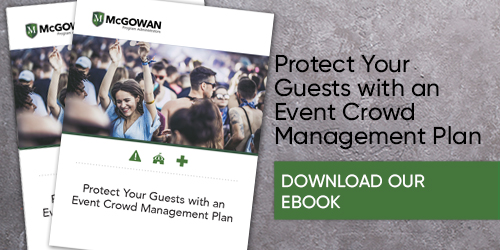When do you need a venue risk assessment? The short answer is every time you put on an event. There’s an endless amount of work that goes into planning a successful event. It’s easy to get lost in all the details, but understanding and preparing for risk is one detail that must not be overlooked. Keeping attendees and staff safe is the greatest responsibility for event organizers.
Through the event planning process, an incredible amount of thought and care goes into preserving your event attendees’ experiences and memories. Your business deserves the same level of safety. Protect your business by securing an insurance policy that adequately protects against liability. When your company is properly protected against accidents, you can focus more energy on keeping your patrons and staff safe, as well.
As an event organizer, you can’t predict the future, but you can get a sense of the possibilities and prepare for them. Having a plan in place in the case of an emergency is the best way to protect your patrons and your staff. The first step to ensuring safety at your venue is determining where hazards are likely to occur.

What is a venue risk assessment?
A venue risk assessment is the practice of identifying potential safety hazards that could occur before, during, and after an event. It helps event planners and coordinators prepare for emergencies and ensure events run safely.
The chances of hazards occurring increase as more people are involved in the preparation and execution of an event. One overlooked detail can be disastrous. Conducting a venue risk assessment helps minimize the likelihood of preventable hazards occurring.
Also read:
Amusement Insurance: Finding the Right Plan for Your Client
Venue hazard examples
There’s a lot that can go wrong during an event, and identifying the possibilities is the first step in mitigating your risk. The top five venue hazards that event planners should be aware of and prepare for when conducting a venue risk assessment include:
- Crowd Riots/Commotions: Behavior at concerts and similar events can be unpredictable. Without preparation, event attendees are at a higher risk of bodily harm.
- Unsecured Equipment: Both indoor and outdoor events use massive audiovisual equipment. If not secured properly, it can fall and pose a serious threat.
- Lighting Strikes: Outdoor venues are susceptible to dangerous lightning strikes.
- Insufficient Medical Precautions: No matter how well prepared you are, things can still go wrong. Not having enough onsite medical assistance could be catastrophic.
- Contaminated Food and Beverage: Unsafe transportation and storage of food and beverages can quickly cause outbreaks of foodborne illness.
Also read:
Inspire Guest Confidence with Effective Communication
Conducting a venue risk assessment
It’s the event planner’s responsibility to coordinate with staff and contractors to ensure that equipment, amenities, venue facilities, and consumables are safe before, during, and after an event. A risk assessment involves four components: identification, assessment, management, and documentation.
- Identify risks and prepare
The first step in a venue risk assessment is identifying all potential risks. To help prevent unruly crowds, venues will need to have enough security personnel strategically placed. Security staff must be trained to quickly assess a crowd that is getting out of control. Ensure that dangerous equipment is double, or even triple, checked by multiple parties to confirm it is secured properly. Strategically place emergency medical tents for people to access if they need medical attention. Ensure food vendors have regulatory licenses and can certify the safety of the food they’re serving. - Assess the risk levels
After organizers have recorded all the possible risks, each risk should be assessed for severity and likelihood. Determine how likely it is that an injury will occur when a guest is exposed to risk and the severity of the potential injury. Create a list of risks and give extra attention to the most severe risks first. - Manage the risk
Once you have identified all potential hazards and assigned severity, you are ready to manage them. Managing risk is where actions, measures, and safety protocols are established. This can include removing the hazards you’ve identified, replacing dangerous equipment with safer options, setting up barriers to keep people away from hazards, training key individuals, and introducing specific procedures and protocols for when a specific hazard plays out. - Document
Keep records of every identified risk so it can be reviewed and revised for future safety purposes. Digital recordkeeping tools are easy to use and readily accessible via mobile devices. Documentation not only helps prevent hazards but can verify that an assessment was carried out in the case of litigation.
Your final step: protect yourself from liability
Creating a venue risk assessment is the first step to mitigating risks for your next event. Now that you’ve completed that process and done everything in your power to protect your attendees and your staff, the next and equally important step is getting adequate insurance coverage. McGowan Program Administrators specializes in helping you feel confident that your business will be able to endure the unpredictable.
Contact McGowan Program Administrators today to learn more about how Amusement & Entertainment Insurance can strengthen your business.


